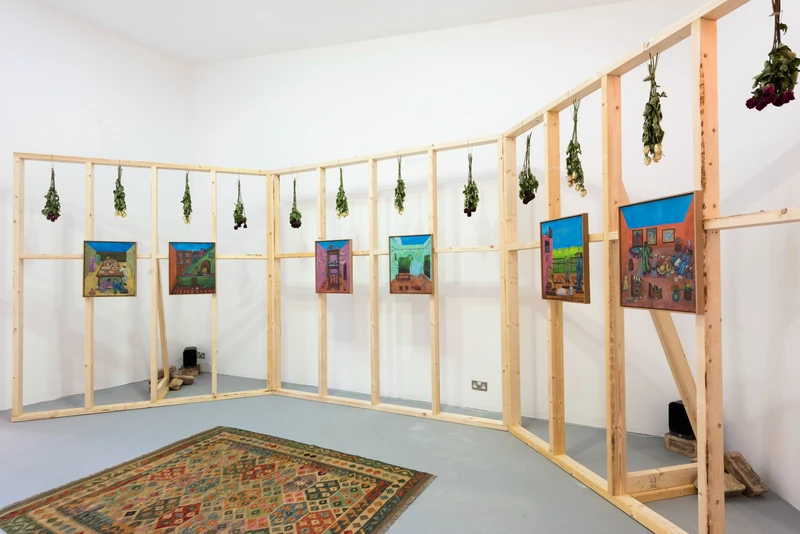Mohammed Z. Rahman: City of Burrows
10 Mar-15 Apr 2023
PV 9 Mar 2023, 6-8pm


We are delighted to present City of Burrows, a solo exhibition of new and existing work by London-based artist Mohammed Z. Rahman at 10 - 16 Grape Street. Interweaving personal, social and folk histories of migration, labour, queerness, family and class, Rahman’s paintings disturb conventions of domestic space and custom in favour of dream logic and moments of magical realism, excavating stories of overlooked figures and everyday resistance.
His works employ the visual language of surrealism and social realism – art movements which, Rahman points out, flourish during times of social unrest: “the former, in that it allows one to dream beyond current conditions and process the unconscious, and the latter, to give voice to the everyday lived experience of the working and non-ruling classes, acting against hegemony.” As dream-like as they are concrete, Rahman’s paintings refer to specific figures, localities and events, employing a near-hieroglyphic symbolism: stories are told via objects scattered over the floors and walls of the work’s interiors. Tools, cut stems, spilled cups, plates of food, silver ingots, discarded pearls and red stilettos contribute to microcosmic scenes of migrants making homes in the UK.
In Unfurnished, an installation commissioned for the 2022 Brent Biennial, six acrylic paintings are mounted on a simple wooden framework, adorned with dried flowers and encircling a kilim rug. Each painting depicts a room in an imagined house, in which a cast of characters are seen eating, sleeping, reading, dancing, working and playing games. None of the rooms have ceilings, opening instead to a luminous blue sky, so that their occupants appear sunlit and exposed. Familiar, cosy scenes are unsettled by colonial spectres and suggestive flashes of violence: smashed glass and ceramics; a small painting of an empty orange dinghy on a rough sea; a gaping red wound at the foot of the stairs, topped with a Met police officer’s hat, a UK army helmet and a beige pith helmet – a nod to historic and ongoing state-sanctioned violence against migrant communities.
2023’s Under the Cloth, a new body of work conceived for City of Burrows, consists of five acrylic paintings illustrating life in East London’s rag trade: an industry heavily populated by Bengali women in the last decades of the twentieth century. The spaces depicted here have a subterranean air: tenements enclosed by bare brick walls and solid ceilings (often punctured by shattered skylights or open hatches through which figures work at sewing machines or smoke in the rafters). The paintings are displayed alongside Rahman’s own mother’s fine paper garment construction patterns and calico samples, gesturing towards the presence of migrant seamstresses typically excluded from historical archives.
Under the Cloth’s sister series, Weighty Scraps (2023), catalogues the material culture of these unsung workers, depicting suggestive encounters between objects charged with domestic mythologies of spirituality, industry, food and sexuality. Cook Serve Become a Man (2018) is a series which similarly enfolds culinary gesture with the politics of gender, aligning the production of working class migrant masculinities with the crisis of patriarchal and racialised power struggles.
Elsewhere, further interior dioramas act as portals into Rahman’s memories and dreams: overlapping realms where individual narrative takes shape. Three postcard-scale watercolours (each 2018) offer surreal, intimate glimpses into episodes of personal significance, the figure of the artist watching on from within the frame.
Over two small, square paintings, Two Rooms in My Heart (2021) sees a pair of box-like rooms connected by a small window through which earth spills onto the floor, a connecting burrow between scenes of tenderness and tragedy. In City of Burrows, Rahman tunnels between the domestic and the magical; the myths, histories and lived experiences of the city.
City of Burrows press release
Download